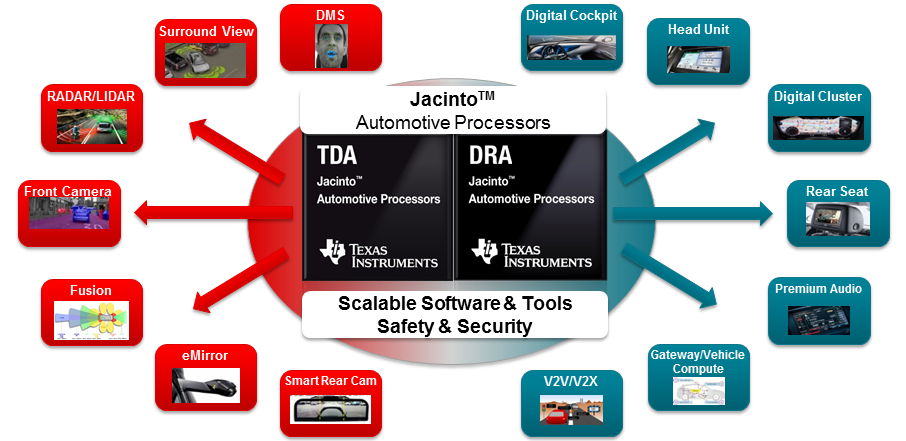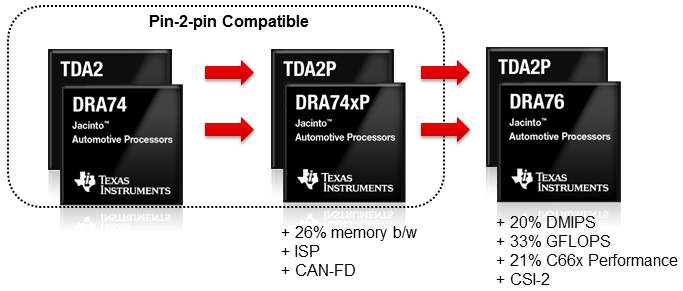SSZT847 december 2017
TI will continue to develop scalable, cost-effective automotive system on chips (SoCs) with the performance and features required to enable OEMs to get closer to autonomous driving and an integrated cockpit (multi-operating system/multi-domain systems). But to do so starts with ensuring that we support our processors with unified software, security and safety-enabling solutions.
The TDA family of processors for ADAS applications will now be part of the Jacinto™ automotive processors platform, which includes the DRA family of infotainment and cluster SoCs, shown in Figure 1. To complement their common architecture, our software development kits (SDKs) and tools support both the TDA and DRA families in addition to having a regular cadence of updates. Our goal with this synergy is to enable OEMs and Tier-1 manufacturers to leverage the software scalability of the platform to reduce R&D investments and time to market.
 Figure 1 Applications Supported by TDA
and DRA Device Families
Figure 1 Applications Supported by TDA
and DRA Device FamiliesEvery year, cars become smarter and more connected as the market continues to evolve toward automated driving and the integrated cockpit. ADAS equipment now comprises multiple signal inputs from cameras, ultrasonic, radar and LIDAR sensors to determine a vehicle’s course of action. Infotainment systems include multiple high-resolution displays and are becoming integrated with other domains of the car, such as the instrument cluster, to seamlessly provide needed content to drivers.
As a result, performance and feature requirements of ADAS equipment and infotainment systems have increased, while design budgets have stayed the same. The number of engine control units (ECUs) in vehicles has also increased, leading Tier-1s and OEMs to invest significantly in software development while ensuring that their systems comply with automotive standards.
To support the rapidly evolving automotive market, the TDA2P and DRA76 are scalable extensions to the Jacinto automotive SoC platform and consist of:
- The integration of an imaging subsystem (ISS) with an image signal processor (ISP), already featured on TDA3 processors, for bill-of-materials savings on surround-view and ADAS/autonomous driving applications.
- An approximate 25% to 30% increase in the performance in key cores such as C66x digital signal processors (DSPs), Arm® Cortex®-A15 processors, graphics processing units (GPUs), ISPs and improved memory bandwidth.
- Support for next-generation interfaces such as Controller Area Network-Flexible Data Rate (CAN-FD) and Camera Serial Interface (CSI-2), enabling innovation at a reduced cost.
In addition to enabling software compatibility with their respective Jacinto predecessors, you can optimize the heterogeneous architecture of TDA2P and DRA76 devices, shown in Figure 2, for different ADAS and infotainment and cluster applications, including:
- TDA2P: cost-effective camera monitoring systems (CMSs or e-mirrors) and, 3-D surround view by leveraging the integrated ISP, CSI-2 and CAN-FD.
- DRA76: support for high-resolution displays of up to 2880x1080 pixels; multiple 1080p display capability; multi-operating system/multi-domain systems; and integrated surround view by leveraging the additional headroom provided by GPUs, MPUs, memory bandwidth and ISP integration.
 Figure 2 DRA76 and TDA2P Features and
Performance Improvements
Figure 2 DRA76 and TDA2P Features and
Performance ImprovementsSolutions designed on this scalable architecture, along with TI’s SDKs, enable cost savings and faster time to market.
Brooke Williams contributed to this post.
Additional Resources
- Download these white papers:
- Read these TI E2E™ Community blog posts: